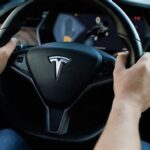
U.S. regulators are intensifying scrutiny of Tesla’s planned robotaxi service, raising concerns about the safety and operational capabilities of the autonomous vehicles. The National Highway Traffic Safety Administration (NHTSA) is reportedly seeking detailed information from Tesla regarding the design, functionality, and safety protocols of the robotaxi, which CEO Elon Musk aims to launch later this year. This heightened regulatory interest follows years of investigation into Tesla’s Autopilot and Full Self-Driving (FSD) systems and precedes the anticipated unveiling of the robotaxi prototype on August 8.
The NHTSA’s inquiry reflects a growing apprehension surrounding autonomous vehicle technology and its potential impact on public safety. The agency’s scrutiny extends beyond Tesla, encompassing the broader autonomous vehicle industry, but Tesla’s prominent position and Musk’s ambitious timelines have placed the company under a particularly intense spotlight. The regulatory pressure underscores the challenges Tesla faces in bringing fully autonomous vehicles to market amid safety concerns and technological hurdles.
Regulatory Scrutiny Intensifies
The NHTSA’s request for information from Tesla signals a deeper dive into the company’s robotaxi program. While the agency has been investigating Tesla’s Autopilot and FSD systems for several years, the focus on the robotaxi indicates a specific concern about the safety implications of a fully autonomous vehicle operating without a human driver. The NHTSA’s mandate is to ensure vehicle safety and protect the public from unreasonable risks associated with motor vehicle defects or noncompliance with safety standards.
According to the Yahoo Finance report, the NHTSA is “circling” Tesla, indicating a proactive approach to gathering information and assessing the risks associated with the robotaxi. This heightened scrutiny likely stems from previous investigations into Tesla’s driver-assistance systems, which have been linked to numerous accidents and incidents, some involving serious injuries and fatalities.
The investigation into Tesla’s Autopilot system, which began in August 2021, has focused on the system’s performance in detecting and responding to emergency vehicles and other hazards. The NHTSA has also opened investigations into Tesla’s FSD system, examining its ability to navigate complex driving scenarios and avoid collisions. These prior investigations have provided the NHTSA with a wealth of data and insights into Tesla’s autonomous driving technology, informing their current assessment of the robotaxi.
Tesla’s Autonomous Ambitions
Elon Musk has repeatedly emphasized Tesla’s commitment to achieving full self-driving capability. The robotaxi program represents a critical component of Tesla’s long-term vision, with Musk envisioning a future where autonomous vehicles revolutionize transportation and generate substantial revenue for the company through a ride-hailing service.
Musk has stated that the robotaxi will be a purpose-built vehicle, designed specifically for autonomous operation. He has suggested that it may lack traditional controls like a steering wheel and pedals, reflecting the company’s confidence in its autonomous driving technology. The unveiling of the robotaxi prototype on August 8 is expected to provide further details about the vehicle’s design, features, and capabilities.
However, Tesla’s autonomous ambitions have been met with skepticism from some industry experts and regulators. Concerns have been raised about the maturity of Tesla’s technology, the adequacy of its safety testing, and the potential for unforeseen risks in real-world driving conditions. The NHTSA’s investigation underscores these concerns and highlights the challenges Tesla faces in convincing regulators and the public that its robotaxi is safe and reliable.
Safety Concerns and Technological Hurdles
The primary concern surrounding Tesla’s robotaxi revolves around safety. Autonomous vehicles must be able to safely navigate a wide range of driving scenarios, including complex intersections, unexpected obstacles, and adverse weather conditions. They must also be able to reliably detect and respond to pedestrians, cyclists, and other vehicles.
Tesla’s autonomous driving technology relies heavily on cameras and neural networks to perceive the environment and make driving decisions. While these systems have shown promise, they are not yet perfect. Cameras can be obscured by rain, snow, or fog, and neural networks can be fooled by adversarial examples or unexpected situations.
Moreover, the ethical considerations surrounding autonomous driving are complex. Autonomous vehicles must be programmed to make split-second decisions in unavoidable accident scenarios, such as choosing between hitting a pedestrian or swerving into oncoming traffic. These decisions raise difficult questions about how to prioritize safety and minimize harm.
The technological hurdles to achieving full autonomy are significant. While Tesla has made substantial progress in developing its autonomous driving technology, it still faces challenges in achieving the level of reliability and robustness required for safe operation without human intervention. The NHTSA’s investigation will likely focus on these technological limitations and assess whether Tesla has adequately addressed the safety concerns they raise.
Impact on the Autonomous Vehicle Industry
The NHTSA’s scrutiny of Tesla’s robotaxi has implications for the broader autonomous vehicle industry. The agency’s findings and regulatory actions could set precedents for the development and deployment of autonomous vehicles by other companies. A rigorous and transparent regulatory framework is essential for fostering public trust in autonomous vehicle technology and ensuring its safe integration into the transportation system.
Several other companies are also developing autonomous vehicles, including Waymo, Cruise, and Amazon’s Zoox. These companies are pursuing different approaches to autonomous driving, using a variety of sensors and software algorithms. The NHTSA is closely monitoring the progress of these companies and is working to develop standards and guidelines for autonomous vehicle safety.
The development of autonomous vehicle technology has the potential to transform transportation, reduce traffic congestion, and improve safety. However, it also poses significant challenges, including technological hurdles, ethical dilemmas, and regulatory uncertainties. The NHTSA’s role is to balance the potential benefits of autonomous vehicles with the need to protect public safety.
Tesla’s Response and Future Outlook
Tesla has maintained that its autonomous driving technology is safe and that it is committed to working with regulators to address their concerns. The company has invested heavily in developing and testing its Autopilot and FSD systems, and it has released numerous software updates to improve their performance and safety.
However, Tesla has also faced criticism for its aggressive marketing of its autonomous driving features and for what some perceive as a lack of transparency about the limitations of its technology. The NHTSA’s investigation may prompt Tesla to be more cautious in its claims about its autonomous driving capabilities and to provide more detailed information about the safety testing it has conducted.
The future of Tesla’s robotaxi program is uncertain. The NHTSA’s investigation could delay or even prevent the launch of the service. However, Tesla remains committed to its autonomous ambitions, and it is likely to continue investing in the development of its technology. The success of Tesla’s robotaxi program will depend on its ability to convince regulators and the public that its vehicles are safe and reliable.
Financial Implications for Tesla
The delay or cancellation of the robotaxi project would have substantial financial ramifications for Tesla. Musk has repeatedly emphasized the robotaxi’s potential to generate significant revenue for the company through a ride-hailing service. Missing this revenue stream could impact Tesla’s stock price and overall financial performance. The autonomous driving segment is crucial for Tesla’s future valuation. Investors are keenly watching developments in this area, and any adverse regulatory outcomes could negatively affect investor confidence.
Moreover, developing and deploying autonomous vehicles requires substantial capital investment in research, development, and testing. A setback in the robotaxi program could force Tesla to reallocate resources and potentially delay other projects. The uncertainty surrounding the regulatory environment could also make it more difficult for Tesla to attract investors and raise capital for its autonomous vehicle initiatives.
Public Perception and Adoption
Public perception of autonomous vehicles is critical for their widespread adoption. Safety concerns and skepticism about the reliability of the technology could hinder public acceptance, even if the vehicles are technically capable of operating safely. Tesla’s reputation has taken hits because of Autopilot-related accidents, which have increased public unease about autonomous driving.
Building public trust in autonomous vehicles requires transparency, rigorous testing, and a clear regulatory framework. The NHTSA’s investigation plays a crucial role in ensuring that autonomous vehicles are safe and that the public is adequately protected. Positive regulatory outcomes could enhance public confidence, paving the way for broader adoption of autonomous vehicle technology.
Conversely, negative findings or regulatory restrictions could further erode public trust and delay the widespread adoption of autonomous vehicles. Public education and outreach efforts are also essential for informing people about the capabilities and limitations of autonomous driving technology.
International Regulatory Landscape
The regulatory landscape for autonomous vehicles varies significantly across different countries. Some countries, like Germany and the United Kingdom, have adopted relatively permissive regulations, allowing for limited testing and deployment of autonomous vehicles. Other countries, like China, are taking a more cautious approach, requiring extensive testing and certification before autonomous vehicles can be operated on public roads.
Tesla must navigate this complex international regulatory landscape as it seeks to expand its autonomous vehicle operations globally. The company must comply with the specific regulations of each country in which it operates, which can be a time-consuming and expensive process. Coordinating regulatory strategies across different countries is essential for ensuring consistent safety standards and facilitating the global adoption of autonomous vehicle technology.
The Role of Technology in Regulation
Regulatory bodies, including the NHTSA, are adapting to the fast-paced technological advancements in autonomous driving. Incorporating technology into the regulatory process can enhance the efficiency and effectiveness of oversight. For example, regulators can use simulation and modeling tools to assess the safety performance of autonomous vehicles in a wide range of scenarios.
Data analytics can also play a crucial role in identifying potential safety risks and monitoring the performance of autonomous vehicles in real-world driving conditions. Regulators can collect and analyze data from autonomous vehicles to identify trends, detect anomalies, and assess the effectiveness of safety measures.
Moreover, regulators can leverage artificial intelligence (AI) and machine learning (ML) to automate certain aspects of the regulatory process, such as reviewing safety reports and identifying potential violations. Embracing technology can enable regulators to keep pace with the rapid development of autonomous vehicle technology and ensure that it is deployed safely and responsibly.
Expanding on Tesla’s Technological Approach
Tesla’s approach to autonomous driving relies heavily on vision-based systems, utilizing cameras as its primary sensor. This contrasts with some competitors, such as Waymo, which employ a more sensor-rich approach that includes lidar (light detection and ranging) and radar in addition to cameras. Lidar provides a detailed 3D map of the surroundings, which can be particularly useful in challenging weather conditions.
The debate over the optimal sensor suite for autonomous vehicles is ongoing. Proponents of lidar argue that it provides superior accuracy and reliability compared to cameras alone. However, lidar systems are typically more expensive than cameras, which can increase the cost of autonomous vehicles.
Tesla has argued that its vision-based system is sufficient for achieving full autonomy and that lidar is not necessary. The company has been working to improve the performance of its camera-based system through advancements in neural networks and computer vision algorithms.
The NHTSA’s investigation will likely assess the strengths and limitations of Tesla’s vision-based approach and compare it to other sensing technologies. The agency may also consider the redundancy and robustness of Tesla’s sensor suite, ensuring that the system can operate safely even if one or more sensors fail.
Ethical Considerations in Autonomous Driving
Autonomous vehicles raise complex ethical questions about how to program them to make decisions in unavoidable accident scenarios. For example, if an autonomous vehicle is faced with a situation where it must choose between hitting a pedestrian or swerving into oncoming traffic, how should it be programmed to decide?
These ethical dilemmas have no easy answers, and different people may have different opinions about the appropriate course of action. Some argue that autonomous vehicles should be programmed to prioritize the safety of their occupants, while others argue that they should prioritize the safety of pedestrians and other vulnerable road users.
Developing ethical guidelines for autonomous driving requires careful consideration of a wide range of factors, including moral principles, legal obligations, and societal values. Regulatory bodies, industry stakeholders, and ethicists must work together to develop a framework that addresses these complex ethical issues.
The Importance of Cybersecurity
Cybersecurity is another critical aspect of autonomous vehicle safety. Autonomous vehicles are connected to the internet and rely on software and data to operate, making them vulnerable to cyberattacks. Hackers could potentially gain control of an autonomous vehicle and use it to cause accidents or steal data.
Protecting autonomous vehicles from cyberattacks requires robust security measures, including encryption, firewalls, and intrusion detection systems. Manufacturers must also implement secure software development practices to minimize the risk of vulnerabilities.
Regulatory bodies are increasingly focused on cybersecurity risks associated with autonomous vehicles. The NHTSA has issued guidance on cybersecurity best practices for the automotive industry, and it is working to develop standards and regulations to address cybersecurity vulnerabilities in autonomous vehicles.
Long-Term Implications for Urban Planning and Transportation
The widespread adoption of autonomous vehicles has the potential to transform urban planning and transportation systems. Autonomous vehicles could reduce traffic congestion, improve accessibility for people with disabilities, and enable new forms of transportation, such as ride-sharing and micro-mobility.
However, the transition to autonomous vehicles also poses challenges for urban planners. Cities must adapt their infrastructure to accommodate autonomous vehicles, including building new roads, upgrading traffic signals, and developing charging infrastructure.
Autonomous vehicles could also have implications for land use patterns. If autonomous vehicles make it easier to commute long distances, people may be more likely to live in suburban or rural areas, leading to urban sprawl.
Careful planning and coordination are essential to ensure that the transition to autonomous vehicles benefits society as a whole. Urban planners, transportation officials, and policymakers must work together to address the challenges and opportunities presented by autonomous vehicle technology.
The Future of Personal Vehicle Ownership
The rise of robotaxis could disrupt the traditional model of personal vehicle ownership. If robotaxis become widely available and affordable, people may be less likely to own their own cars. This could have significant implications for the automotive industry, as well as for related industries such as insurance and parking.
However, it is also possible that robotaxis will complement, rather than replace, personal vehicle ownership. Some people may still prefer to own their own cars for convenience, privacy, or personal preference.
The future of personal vehicle ownership will depend on a variety of factors, including the cost and availability of robotaxis, the level of public trust in autonomous vehicles, and the preferences of individual consumers.
FAQ Section
1. What exactly is a robotaxi, and how does it differ from current ride-sharing services?
A robotaxi is an autonomous vehicle designed to operate as a taxi service without a human driver. Unlike current ride-sharing services like Uber or Lyft, which rely on human drivers, robotaxis are intended to navigate and operate entirely independently using advanced sensors, software, and artificial intelligence. This means passengers can hail a ride and be transported to their destination without any human intervention during the journey. The goal is to provide a more efficient, cost-effective, and potentially safer transportation option, pending regulatory approval and technological advancements.
2. What are the main safety concerns regulators have regarding Tesla’s robotaxi?
Regulators, such as the NHTSA, are primarily concerned with the safety and reliability of Tesla’s robotaxi technology. Key concerns include:
- Performance in Complex Scenarios: Ensuring the robotaxi can handle unexpected situations, challenging weather conditions (rain, snow, fog), and complex intersections safely.
- Sensor Reliability: Verifying the reliability and accuracy of the sensors (cameras, radar, potentially lidar in future versions) used for perception, especially in adverse conditions or when sensors are obstructed.
- Emergency Response: Assessing how the robotaxi will handle emergencies, such as system failures, accidents, or sudden obstacles, and whether it can safely bring the vehicle to a stop.
- Cybersecurity: Protecting the vehicle from cyberattacks that could compromise its safety or control.
- Ethical Decision-Making: Evaluating how the robotaxi will make ethical decisions in unavoidable accident scenarios, balancing the safety of passengers, pedestrians, and other vehicles.
3. How might the NHTSA’s investigation impact Tesla’s timeline for launching its robotaxi service?
The NHTSA’s investigation could significantly impact Tesla’s timeline for launching its robotaxi service. A thorough investigation could lead to:
- Delays: If the NHTSA identifies safety concerns, it could require Tesla to make modifications to the robotaxi’s design or software, pushing back the launch date.
- Stricter Regulations: The investigation could result in stricter regulations and testing requirements for autonomous vehicles, which Tesla would need to comply with before launching its service.
- Limited Deployment: The NHTSA might initially approve a limited deployment of the robotaxi service in specific geographic areas or under certain conditions to gather more data and assess its safety in real-world scenarios.
- Possible Rejection: In a worst-case scenario, if the NHTSA finds significant safety flaws, it could reject Tesla’s application to launch the robotaxi service altogether, requiring substantial redesign and re-evaluation.
4. What are the potential benefits of robotaxis for consumers and society?
Robotaxis offer several potential benefits:
- Lower Transportation Costs: By eliminating the need for human drivers, robotaxis could potentially offer lower fares compared to traditional taxis or ride-sharing services.
- Increased Accessibility: Robotaxis could improve transportation accessibility for people with disabilities, the elderly, and those who do not own a car or cannot drive.
- Reduced Traffic Congestion: Optimized routing and coordination of autonomous vehicles could help reduce traffic congestion in urban areas.
- Improved Safety: If proven safe and reliable, robotaxis could reduce accidents caused by human error, such as drunk driving, distracted driving, or fatigue.
- Greater Efficiency: Robotaxis could operate 24/7, providing on-demand transportation at any time of day or night.
- Parking Efficiency: Since robotaxis do not need to park for extended periods, this could reduce the need for parking spaces in cities, freeing up land for other uses.
5. What are some of the other companies besides Tesla working on robotaxi technology, and how do their approaches differ?
Several other companies are actively developing robotaxi technology, each with their own unique approaches:
- Waymo (Alphabet): Waymo has been developing autonomous driving technology for over a decade and operates a limited robotaxi service called Waymo One in certain areas. Their approach emphasizes a comprehensive sensor suite, including lidar, radar, and cameras, and focuses on geofenced areas with detailed mapping.
- Cruise (General Motors): Cruise is another major player in the autonomous vehicle space. They have also been testing robotaxis in select cities and are working towards commercial deployment. Cruise vehicles also heavily rely on lidar, radar, and cameras for a comprehensive sensing system.
- Zoox (Amazon): Zoox is developing a purpose-built robotaxi vehicle designed from the ground up for autonomous operation. Their vehicle features a unique bidirectional design and emphasizes redundancy in its sensors and systems.
- Argo AI (Ford & Volkswagen – Ceased Operations): Although Argo AI ceased operations in 2022, they represent a collaborative effort between major automakers to develop autonomous driving technology. The company primarily focused on using lidar technology in their vehicles. Their closure highlights the difficulty and capital-intensive nature of autonomous driving development.
These companies’ approaches often differ in terms of their sensor suites (e.g., reliance on lidar vs. vision-based systems), their development strategies (e.g., geofenced vs. broader deployment), and their business models (e.g., ride-hailing service vs. technology licensing). They are all striving to create safe and reliable autonomous transportation solutions, but they are taking different paths to achieve that goal.









